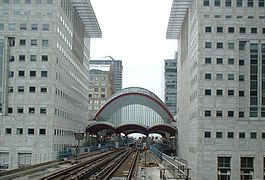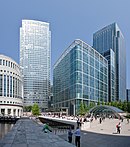Canary Wharf DLR station
| Canary Wharf | |
|---|---|
 Station viewed from the south | |
| Location | Canary Wharf |
| Local authority | London Borough of Tower Hamlets |
| Managed by | Docklands Light Railway |
| Number of platforms | 6 (facing 3 tracks) |
| Accessible | Yes[1] |
| Fare zone | 2 |
| OSI | Canary Wharf |
| DLR annual boardings and alightings | |
| 2007–08 | 16.055 million[3] |
| 2008–09 | |
| 2010–11 | |
| 2018 | |
| 2019 | |
| 2020 | |
| 2021 | |
| 2022 | |
| Key dates | |
| 1991 | Opened |
| Other information | |
Canary Wharf DLR station is a Docklands Light Railway (DLR) station in Canary Wharf, east London, England. Built into the base of One Canada Square, between two parts of a shopping centre,[10] it serves the Canary Wharf office complex. The station itself has six platforms serving three rail tracks and is sheltered by a distinctive elliptical glass roof.
The station is located on the DLR between Heron Quays station and West India Quay station, in Travelcard Zone 2, which are in fact the three closest railway stations on the same line in the world.[citation needed] The station is shown on the Tube map as being within walking distance of Canary Wharf tube station;[11] however, Heron Quays DLR station is indicated as closer by around 50 metres.
History

Canary Wharf station had been part of the original DLR plans, but when the system opened in August 1987 the station was not ready.[12] It was originally planned that the station would be similar to the original station at Heron Quays, with two small platforms either side of the tracks. It soon became apparent that the Canary Wharf development would produce demand well above the capacity of a simple station. On 17 July 1987 (over a month before the DLR opened to the public) a contract was awarded to GEC-Mowlem Railway Group to rebuild the station into the considerably more elaborate and spacious design that exists today. It was opened in November 1991.[12]
Rail service and frequency
Canary Wharf is served by two lines of the DLR — Bank to Lewisham and Stratford to Lewisham. Service to Bank comes at 3.5 minute intervals from 6.30am to 10.00am; four minute intervals from 4.30pm to 7.30pm; seven minutes intervals from 7.30pm to 9pm; and ten minute intervals from 5.30am to 6.30am, 10am to 4pm, and 9pm to 12.30am.[13] There are also occasional services between Tower Gateway and Lewisham or Crossharbour.
Connections
London Buses routes 135, 277, D3, D7 and D8 and night route N550 serve the station.
See also
References
- ^ "Step free Tube Guide" (PDF). Transport for London. April 2021. Archived (PDF) from the original on 15 May 2021.
- ^ "Out-of-Station Interchanges" (Microsoft Excel). Transport for London. 2 January 2016. Retrieved 28 August 2016.
- ^ a b Template:Citation DLR bat 1
- ^ Template:Citation DLR bat 2
- ^ "Station Usage Data" (XLSX). Usage Statistics for London Stations, 2018. Transport for London. 23 September 2020. Retrieved 9 January 2022.
- ^ "Station Usage Data" (XLSX). Usage Statistics for London Stations, 2019. Transport for London. 23 September 2020. Retrieved 9 January 2022.
- ^ "Station Usage Data" (XLSX). Usage Statistics for London Stations, 2020. Transport for London. 16 April 2021. Retrieved 9 January 2022.
- ^ "Station Usage Data" (XLSX). Usage Statistics for London Stations, 2021. Transport for London. 12 July 2022. Retrieved 7 September 2022.
- ^ "Station Usage Data" (XLSX). Usage Statistics for London Stations, 2022. Transport for London. 4 October 2023. Retrieved 20 October 2023.
- ^ Canary Wharf - Transport for London TfL official site Retrieved 3 September 2007
- ^ Tube map TfL official site Retrieved 3 September 2007
- ^ a b DLR history timeline TfL official site Retrieved 3 September 2007
- ^ DLR frequencies TfL official site Retrieved 4 September 2007
External links
- Canary Wharf station on Docklands Light Railway's website

